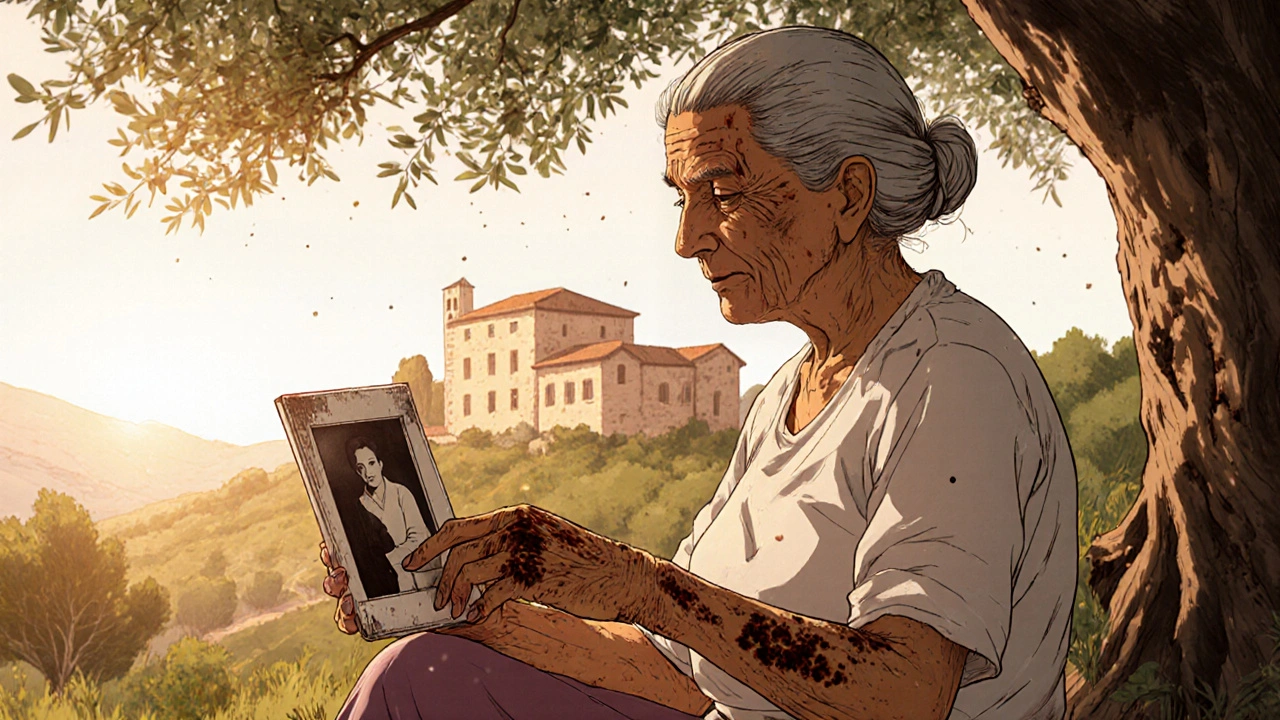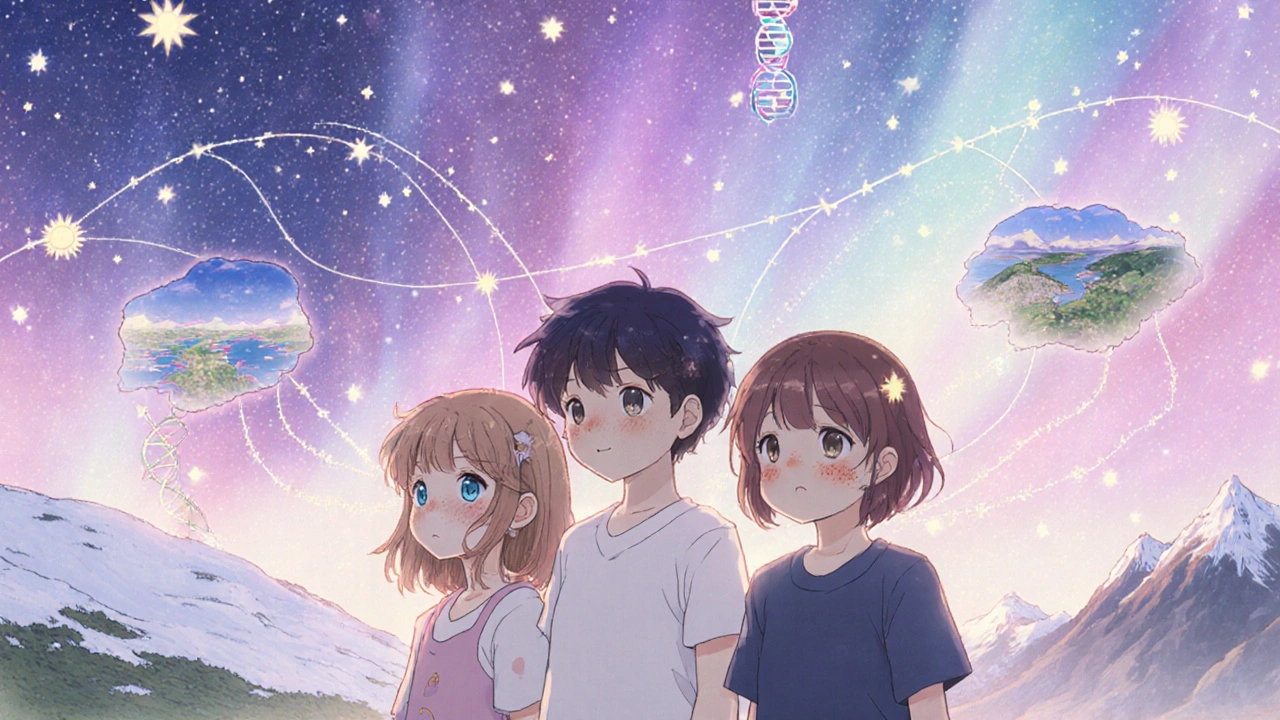
Not all freckles are the same. Some fade in winter, others stay dark all year. Some show up in childhood, others appear after sunburns. The kind of freckles you have isn’t just about sun exposure-it’s written in your DNA. If you’ve ever wondered why your freckles look different from your sibling’s, or why your grandparents had them but your parents didn’t, the answer lies in your ancestry. There are two main types of freckles, and each tells a different story about where your family came from and how your skin reacts to light.
Ephelides: The Sun-Triggered Freckles
Ephelides are the classic freckles most people picture-small, light brown spots that show up on the face, arms, and shoulders. They’re most common in people with fair skin, red or blonde hair, and blue or green eyes. These freckles don’t exist without sunlight. Walk into a dark room for a few months, and they’ll fade. Come back outside in spring, and they’ll return like clockwork.
This type is strongly tied to a gene called MC1R. If you carry certain variants of this gene, your skin produces less melanin overall and makes it in uneven patches when exposed to UV rays. That’s what creates the freckles. The MC1R gene is most common in people of Northern European descent. About 80% of people with red hair carry at least one version of it. But you don’t need red hair to have it-many people with light skin and freckles carry the gene without ever having red hair.
Studies show that ephelides appear in children as young as two or three, especially after their first few summers in sunny climates. They peak in adolescence and often fade after age 30. If your freckles behave this way-bright in summer, gone in winter-you’re likely descended from ancestors who lived in regions with low year-round sunlight, like Ireland, Scotland, or Scandinavia. Their skin evolved to make the most of weak sun, but that same adaptation makes freckles pop up easily.
Lentigines: The Permanent Sunspots
Lentigines, often called liver spots or sunspots, look like freckles but behave differently. They’re darker, larger, and don’t fade with the seasons. You’ll see them on the backs of hands, forearms, and face in people over 40. Unlike ephelides, they’re caused by long-term sun damage, not just genetics. But here’s the twist: your genes still play a role.
Lentigines are more common in people with ancestry from Southern Europe, the Mediterranean, or the Middle East. These populations have darker skin tones than Northern Europeans, but still carry genes that make melanin production unstable under UV stress. Over decades, repeated sun exposure causes melanocytes to cluster and produce too much pigment in patches. The result? Dark, stubborn spots that stick around.
Unlike ephelides, lentigines aren’t linked to the MC1R gene. Instead, they’re tied to genes that control how skin cells repair DNA after UV exposure. People with ancestry from sunnier regions often have better baseline protection against sunburn, but that doesn’t stop cumulative damage. That’s why you’ll see lentigines in older adults from Spain, Italy, or Greece-even if they never had freckles as kids.
How Freckles Reveal Your Genetic History
Your freckles are like a map of your ancestors’ environment. If you have ephelides, your family likely came from cloudy, northern climates where sunlight was rare. Your skin evolved to maximize vitamin D production from minimal UV. That meant less overall melanin and more sensitivity to light. Freckles were a side effect-a sign your body was trying to protect itself in a low-light world.
If you have lentigines, your ancestors probably lived under stronger sun. Their skin adapted to block more UV, but over time, the sun’s damage built up. These spots are a sign of long-term exposure, not just genetics. But even here, your genes matter. People with certain versions of the SLC24A5 gene-common in Mediterranean and South Asian populations-are more likely to develop lentigines after decades in the sun.
There’s also a third, rarer pattern: freckles that appear only on the nose and cheeks, even in people with darker skin. This is often seen in East Asian populations and is linked to a gene called IRF4. These freckles are smaller and more uniform than ephelides, and they don’t fade as easily. They’re not caused by sunburn-they’re a genetic trait passed down through generations in China, Korea, and Japan. This shows that freckles aren’t just a European thing. Different populations developed different versions of the same trait.

What Freckles Don’t Tell You
Just because you have freckles doesn’t mean you’re more likely to get skin cancer. But it does mean you need to be more careful. People with ephelides have a higher risk of melanoma because their skin has less natural protection. The same MC1R gene that causes freckles also makes skin cells more vulnerable to UV damage. That’s why dermatologists recommend regular skin checks for people with lots of freckles, regardless of age.
Lentigines, on the other hand, are usually harmless. But if a spot suddenly changes shape, bleeds, or becomes raised, it could be something else-like actinic keratosis or even early melanoma. That’s why it’s important to know the difference between a benign sunspot and something dangerous. A dermatologist can tell you with a quick exam and a dermatoscope.
Also, freckles don’t tell you your exact ethnicity. You can have ephelides and be part Native American, or have lentigines and have Irish roots. Genetics don’t work in neat boxes. But they do give you clues. If your great-grandmother had freckles and your grandmother didn’t, that’s a sign your family’s exposure to sunlight changed over generations-maybe they moved from a coastal village to a city, or switched from farming to office work.
What You Can Do With This Knowledge
Understanding your freckle type helps you protect your skin better. If you have ephelides, wear sunscreen daily-even in winter. Your skin is still reacting to UV, even when you can’t see the freckles. Use SPF 30 or higher, and reapply every two hours if you’re outside.
If you have lentigines, focus on preventing new ones. Wear wide-brimmed hats, avoid midday sun, and use topical retinoids or vitamin C serums. These can help fade existing spots over time. Laser treatments work too, but they’re not a fix unless you stop the sun exposure.
And if you’re curious about your ancestry, freckles can be a starting point. Look at old family photos. Did your relatives have them? Where did they live? Did they work outside? These details, combined with your skin’s reaction to the sun, can give you a clearer picture of where your family came from-even without a DNA test.

When to See a Dermatologist
Most freckles are harmless. But watch for these signs:
- A spot that changes size, shape, or color in a few months
- A freckle that becomes raised, itchy, or bleeds
- A dark spot that looks different from the rest-like it has uneven borders
- A new spot appearing after age 40, especially if you didn’t have freckles before
If you notice any of these, get it checked. Skin cancer doesn’t always look like a textbook case. Sometimes it starts as a freckle that just won’t go away.
Can you get freckles without sun exposure?
Only in rare cases. Most freckles need UV light to appear. But some people are born with genetic freckles-called congenital lentigines-that show up without sun exposure. These are usually larger, darker, and present from birth. They’re linked to rare genetic conditions like LEOPARD syndrome or Peutz-Jeghers syndrome, not normal ancestry patterns.
Do freckles mean you have less melanin overall?
Yes, for ephelides. People with these freckles produce less melanin overall, which is why they burn easily. The freckles themselves are just areas where melanin is clustered. It’s not that they have more pigment-they have less overall, and it’s distributed unevenly. People with lentigines, however, often have normal or even higher melanin levels, but their skin overproduces pigment in response to sun damage.
Can you develop freckles later in life?
You can develop new sunspots (lentigines) at any age if you’ve had enough sun exposure. But true ephelides-freckles that fade in winter-usually appear in childhood and fade after 30. If you suddenly get new small, light brown spots after age 40, they’re likely lentigines, not childhood freckles returning.
Do freckles run in families?
Yes, very often. If one or both of your parents have freckles, you’re more likely to have them too. The MC1R gene is inherited in an autosomal dominant pattern, meaning you only need one copy to express the trait. But environment matters too. Two siblings with the same genes might have very different freckling patterns depending on how much sun they got as kids.
Are freckles more common in certain countries?
Ephelides are most common in Ireland, Scotland, Wales, and parts of Scandinavia, where over 80% of the population has fair skin and freckles. Lentigines are more common in Mediterranean countries like Italy, Greece, and Spain, and in parts of the Middle East and North Africa. In East Asia, freckles are less common but still occur, especially in southern regions with more sun exposure.
Final Thoughts
Your freckles aren’t just a cosmetic quirk. They’re a living record of your body’s response to the sun-and your ancestors’ survival in their environment. Whether you have tiny, seasonal spots or stubborn, dark ones, they’re clues to your genetic past. Knowing the difference helps you care for your skin better, understand your heritage, and spot potential risks early. Pay attention to them. They’re telling you something.
Margaret Wilson
November 19, 2025 AT 23:05Okay but like… why does my freckles look like someone spilled a box of cinnamon on my nose?? 😭 I’m 32 and still getting them in winter?? My dermatologist said it’s ‘MC1R drama’ and I just nodded like a bobblehead. I think my ancestors were Vikings who got lost in a fog and just gave up on melanin. 🧊🧃
Abdula'aziz Muhammad Nasir
November 21, 2025 AT 12:45This is a well-researched and thoughtful overview. The distinction between ephelides and lentigines is often blurred in popular science, but your breakdown clarifies the genetic and environmental interplay effectively. For those in tropical climates with intermittent sun exposure, understanding this can prevent unnecessary anxiety about skin changes. It’s also worth noting that cultural perceptions of freckles vary widely - in some societies, they’re seen as a sign of vitality, not just vulnerability.
Tara Stelluti
November 21, 2025 AT 16:28So let me get this straight - my freckles are basically my DNA screaming ‘I’m a walking vitamin D factory with zero chill’? And now I’m supposed to wear sunscreen like it’s a full-time job?? I’ve been ignoring it since 2017 and I’m still alive. My skin’s got a personality. Let it breathe. 😘
Danielle Mazur
November 22, 2025 AT 06:35Did you know the CDC has been quietly tracking freckle patterns since 2005 to predict migration trends? The MC1R gene is being used in biometric profiling. They’re building a ‘freckle map’ to identify ‘at-risk populations’ for surveillance. That’s why your ‘lentigines’ are now flagged as ‘non-compliant pigmentation signatures.’ They already know you’re from Ireland. Don’t look at your reflection anymore.
Mary Follero
November 23, 2025 AT 17:14I love this so much! I’ve got ephelides and my mom has lentigines - we’re basically a living genetics lab. My grandma had both, and she used to say, ‘Honey, your freckles are your ancestors’ sun-kissed hugs.’ Now I wear sunscreen like it’s armor, but I still let my freckles shine. They’re part of my story. If you’re scared of them, try seeing them as tiny maps of your lineage - not flaws. You’re not broken, you’re beautifully adapted. 🌞💖
Will Phillips
November 25, 2025 AT 09:24MC1R gene?? Sun exposure?? You’re telling me my freckles are just a genetic accident?? What about the truth?? The truth is the government implanted microchips in sunscreen in 2012 to track melanin levels and control population growth through UV manipulation. They want you to think it’s ‘ancestry’ so you don’t ask why your freckles disappeared after you moved to Colorado. The sun is a lie. The freckles are the truth. And they’re watching. Always watching.
william volcoff
November 26, 2025 AT 05:44Interesting how the article frames freckles as ancestry markers - but what if they’re not about where your ancestors lived, but how they *survived*? Ephelides might not mean ‘Northern Europe’ - maybe they mean ‘your great-grandma worked the fields under a thin sky and passed down a survival hack.’ It’s not just geography, it’s resilience. And yeah, sunscreen’s non-negotiable. But maybe we should also be asking: what are we losing when we erase these signs of adaptation?
Freddy Lopez
November 26, 2025 AT 19:45There’s a quiet poetry in freckles - they are the skin’s memoir. Not written in ink, but in pigment shaped by light, time, and inherited memory. To dismiss them as mere ‘markers’ is to reduce the body’s history to a checklist. They are not signs of weakness, nor merely genetic noise. They are the quiet echo of ancestors who stared into a northern dawn and learned to live with less, and others who walked under a southern sun and learned to endure more. We are all walking archives.
Brad Samuels
November 28, 2025 AT 18:43I’ve always thought my freckles were cute until I realized they’re basically my skin’s way of saying ‘I need help.’ Now I wear SPF 50 like a badge. Also, my grandma had them, my mom had them, and now my daughter’s got them too. It’s weirdly comforting - like a family heirloom you didn’t ask for but kinda love. Thanks for making me feel less weird about my nose.
Arun Mohan
November 30, 2025 AT 02:21How quaint. You think freckles are about ancestry? Please. In India, we have a 5,000-year-old text called the Sushruta Samhita that classifies skin pigmentation based on doshas and planetary alignments - far more sophisticated than your ‘MC1R’ buzzwords. Your ‘Northern European’ narrative is colonial pseudoscience dressed as biology. My sister has freckles from a genetic variant linked to Vedic sun rituals. You’re just late to the party. And no, sunscreen won’t fix your cultural ignorance.